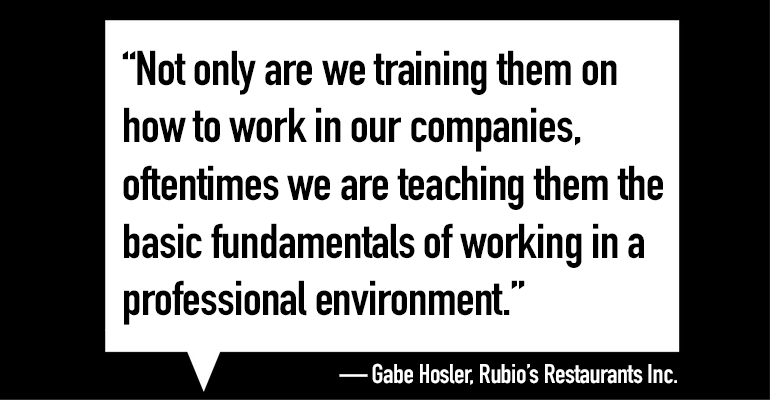This story is part of Restaurant Hospitality’s ongoing series on sexual harassment in the restaurant industry.
While some states, like California since 2016, require companies to provide supervisors with sexual harassment training, restaurant companies — especially with their relatively young workforce as an entry-level employer — are in a crucial position to create and provide tools to deal with the issue.
“Particularly in the restaurant industry, training is critical because we are very often a person’s first job,” said Gabe Hosler, vice president for operations services and training at Carlsbad, Calif.-based Rubio’s Restaurants Inc. and president-elect of the Council of Hotel and Restaurant Trainers.
Related: 7 best practices for sexual harassment training
“Not only are we training them on how to work in our companies, oftentimes we are teaching them the basic fundamentals of working in a professional environment,” Hosler said.
He likened training programs to prevent sexual harassment to airplane safety announcements.
“They become ignored background noise to those who think they know it,” Hosler said. “And although it is preventative, you can’t really apply the knowledge unless something actually happens.”

A company culture with a zero-tolerance policy is crucial, said Michele Lange, director of training and development at Irvine, Calif.-based Habit Restaurants LLC and CHART president.
“As an employer, I feel we need to do the best we can to protect our employees against any type of harassment and bullying from co-workers, vendors and customers,” Lange said.
“It’s important to make people aware of what it is, how to prevent it and steps to take if it does happen.”
Related: What’s the future of sexual harassment at restaurants?
Lange said the training is necessary at every team-member level.
“I wouldn’t classify harassment training as a perfect or imperfect solution, there is no one-size-fits-all solution,” she said. “I feel it really comes down to awareness, building awareness and zero tolerance into your culture. It’s an uncomfortable topic for people to talk about. The more this subject is talked about in orientations on day one of hire, classroom training, meetings, etc., will help to narrow the knowledge gap.”
Patrick Yearout, director of recruiting and training at Seattle, Wash.-based Ivar’s and Kidd Valley Restaurants, said harassment prevention training can provide employees with a sense of workplace safety and protection to help them become more comfortable and develop stronger bonds with the other members of their team.
That is especially vital for restaurants, Yearout added. “If your staff doesn’t gel, you can end up in the weeds pretty quickly during rush periods,” he said.
Yearout said managers need to be aware of possible flaws in harassment prevention training, such as being poorly designed, too advanced or too basic for the intended audience, out of date applied inconsistently from location or difficult to access because of technological or scheduling problems.

“As such, I believe it’s essential for both human resources and operations executives to regularly review and update their policies and training so that they remain effective tools for preventing harassment from occurring,” he said.
Yearout said the anti-harassment policy at Ivar’s and Kidd Valley is introduced to new employees during the onboarding process.
“They know, from the very beginning, that we are committed to providing a professional work environment in which every employee, guest and vendor is treated with respect and that we will not permit discriminatory harassment of any kind,” he said.
Related: How to stop harassment? Make respect a core value
Supervisors follow up with further instruction, Yearout noted.
“It’s essential that employees are aware of what they can do and who they can reach out to if they experience of witness harassment,” he said. “We provide them with the contact information for their district managers, regional managers, director of operations and director of HR so they have multiple avenues of communication and do our best to make them feel comfortable about reporting any situations.”
Restaurants pose specific challenges for training, with many employees working different shifts and on different days to complicate traditional classroom training.
“When you also consider that most quick-service restaurants and operations such as food trucks and concession stands don’t have classroom space on-site, which means they would have to budget for the added expense of rental facilities and travel reimbursement (not to mention the challenge of scheduling an in-person, off-site class in cities or states with new secure scheduling laws),” Yearout noted.

He cited alternatives methods, including:
-Pre-shift meetings, in which unit managers review a few important items each day with the staff prior to the meal period rather than attempting a long-winded data dump;
-In-person communication from district managers or area coaches who visit the restaurant. “As they are representatives who deliver the company culture from the home office, their recognition of the seriousness of the issue speaks volumes and provides the staff with another outlet for discussing issues that arise,” Yearout said.
-Online training modules that are available 24/7 for the staff, deliver consistent learning to everyone who takes the course, and allow for tracking from HR to ensure completion. Yearout said Ivar’s uses Chicago-based DiscoverLink online harassment prevention training.
“We like using them because their courses are focused specifically on the training needs of restaurants; they don’t try to cover offices and factories and shoe stores and hospitals — just restaurants,” he said.
“DiscoverLink’s training also features employees dressed in restaurant employee uniforms and working in restaurant settings. I know that may seem like an odd reason, but for example, the harassment prevention course features employees in polo shirts and aprons talking about scenarios in a kitchen, as opposed to most harassment prevention training courses that show people in business suits discussing harassment while seated at a boardroom table. As a result, it creates much more relevant training for our staffers.”
Letting employees know that company managers are willing to discuss any issue is also crucial, Hosler said.

“One of the most successful tactics … is for an organization to have a culture of open dialogue not only in regard to sexual harassment but any policy in the company where people aren’t afraid to raise their hand and say, ‘I’m not sure if what I am doing is OK,’” Hosler said. “That old ‘if you see something, say something’ sounds good in theory but if people aren’t comfortable speaking up then it’s useless.”
Hosler said expectations must be made very clear to all levels in the company from the line cook to the CEO.
“Expect that from time to time people will do stupid things, but assume innocence and encourage people to speak up on all sides,” he said.
Lange of Habit Restaurants said training isn’t a perfect solution.
“I feel it really comes down to awareness, building awareness and zero tolerance into your culture. It’s an uncomfortable topic for people to talk about,” she said. “The more this subject is talked about in orientations on day one of hire, classroom training, meetings, etc. will help to narrow the knowledge gap.”
The solutions need to start in the executive offices, Lange said. “It has to start with the C-suite and cascade down from there. Management teams need to model positive attitudes and behaviors and deal head on with negative attitudes and behaviors that are not part of the culture.”
Contact Ron Ruggless at [email protected]
Follow him on Twitter: @RonRuggless
